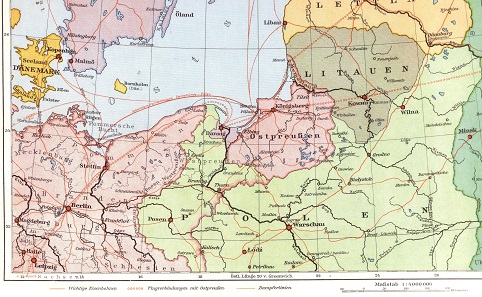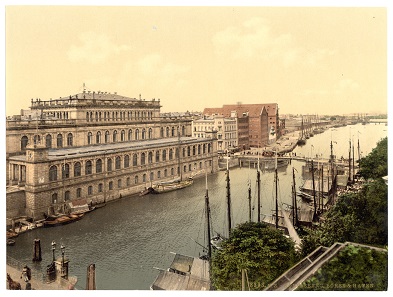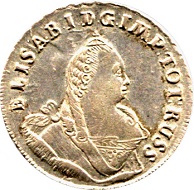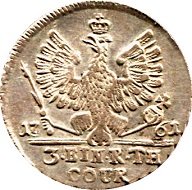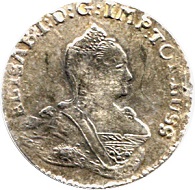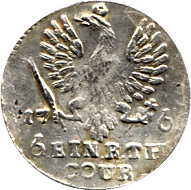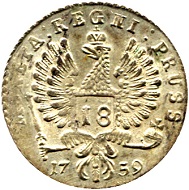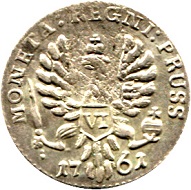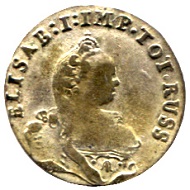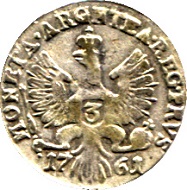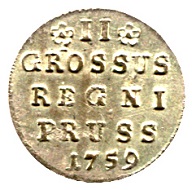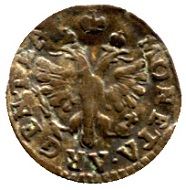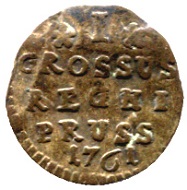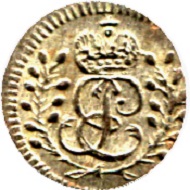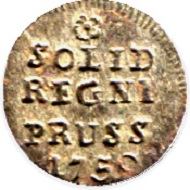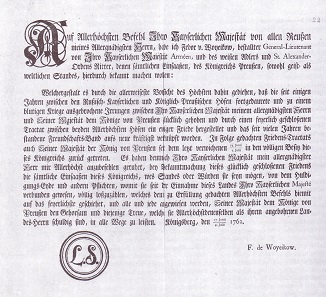As a matter of fact, the Seven Year’s War (1756-1763) might be understood as the first global war in history: All major European powers were involved. On the side of Prussia, there were England and Portugal while on the side of the House of Habsburg, there were France, Russia and Sweden; and these were only the three most significant participants. Their campaigns were not restricted to the European territory but infringed North America, India and the Caribbean. Nevertheless, the decision was made in Europe without involving any army.
Map of East Prussia at the time of the Weimar Republic. The Treaty of Versailles had basically annulled the Partitions of Poland and left Germany with a corridor to East Prussia. The territory’s island position is clear to see even on this map.
East Prussia
An important theater of war was East Prussia, the part of the Prussian Kingdom that lent the House of Hohenzollern their name. This was only possible because East Prussia was located so far east that it did not belong to the Holy Roman Empire of the German Nation. Geographically speaking, it was an exclave in the Polish Kingdom. East Prussia only was not subject to the supremacy of the Polish ruler because he had waived his sovereign rights in 1657. Therewith, the East Prussian ruler was autonomous and free to place a royal crown on his head. This in no way changed anything about the two weak spots of his East Prussian rule: Located far away from the ancestral homeland, the territory was difficult to defend. And the Polish would have loved to incorporate it into their own empire again.
And what did the Russians want in East Prussia?
Elizabeth I of Russia had ambitious plans. To her, the Seven Years’ War came in very handy. Her father Peter I had modernized the country. Now she planned to convert these efforts into an expansion of territory, most preferably to the west where there was a greater density of economic centers. There, however, the Kingdom of Poland was located. If she had been in the position to offer the Kingdom a reasonable change of land, she would have surely gained the Duchy of Courland in turn, which was of great interest to her.
Thus, East Prussia was no mere strategic goal when the Russian army, led by General Apraksin, attacked on July 1, 1757. He won the Battle of Gross-Jaegersdorf, but could not take advantage of his victory. Also his lines of supplies were too long. As a result, the Russian main body was forced to retreat.
Already in the spring of the following year, though, it attacked another time. The Battle of Zorndorf was a horrible bloodbath and modern historians still wonder who has won exactly. The Prussians lost 13,000 men, and the Russians 18,000!
No wonder, then, that Federick’s situation became increasingly threatening. In the Battle of Kunersdorf, he suffered a devastating defeat. Berlin wasn’t taken only for the fact that the allies were interested in other things. Elizabeth wanted East Prussia, and that became the place where the Russian administration took residence.
Bourse and port of Koenigsberg, between 1890 and 1900. Library of Congress. Detroit Publishing Co., catalogue J-foreign section. Detroit, Mich.: Detroit Photographic Company, 1905.; Print no. “8393”.
Russian coins for East Prussia
Elizabeth wasn’t interested in ruining East Prussia. It had to remain an attractive, operating economic territory if she wanted to exchange it for another part of Poland. And an operating economy required an operating monetary system.
And so, the Russians made good use of the Koenigsberg Mint to strike coins for East Prussia between 1759 and 1762. The denominations matched the local ones.
1/3 taler 1761, Koenigsberg. From Auction Tempelhofer Münzenhaus, Berlin, on April 6, 2017.
They consisted of third talers,…
1/6 taler 1761, Koenigsberg or Moscow. From Auction Tempelhofer Münzenhaus, Berlin, on April 6, 2017.
… sixth talers, …
18 groeschers 1759, Koenigsberg. From Auction Tempelhofer Münzenhaus, Berlin, on April 6, 2017.
18 groeschers, also called tympf, …
6 groeschers 1761, Koenigsberg or Moscow. From Auction Tempelhofer Münzenhaus, Berlin, on April 6, 2017.
… 6 groeschers or szostak, …
3 groeschers 1761, Moscow. From Auction Tempelhofer Münzenhaus, Berlin, on April 6, 2017.
… 3 groeschers or duettchen, …
2 groeschers 1759, Koenigsberg. From Auction Tempelhofer Münzenhaus, Berlin, on April 6, 2017.
… 2 groeschers, …
Groschen 1761, Koenigsberg. From Auction Tempelhofer Münzenhaus, Berlin, on April 6, 2017.
… groschen, …
Schilling 1759, Koenigsberg. From Auction Tempelhofer Münzenhaus, Berlin, on April 6, 2017.
… and schilling.
The coins’ design of course changed. From the third taler down to the 3 groeschers, on the obverse we see the bust of Tsarina Elizabeth I with a Latin legend (in translation): Elizabeth I by the grace of God Empress of all Russia. The 2 groeschers, in contrast, only depicts the Russian double eagle with the Latin wording (in translation): silver coin. The smallest denomination, the schilling of which three made a groschen, shows an entwined monogram consisting of E and P for Elizabeth Petrovna (= Elizabeth, daughter of Peter).
The reverse, on the other hand, remains Prussian: It features the crowned eagle with scepter and Imperial orb. Furthermore, every denomination clearly states its value, and the groschen even mentions explicitly that it was a coin of the Kingdom of Prussia (Moneta Regni Prussiae).
Coin imports from Moscow
These coins were very popular, because the Tsarina didn’t take part in the general debasement with which other rulers, like Frederick II, funded their war. Her coins were rather issued in pre-war quality. By decree, the poor war money was banned from the East Prussian markets.
Since the Koenigsberg Mint was not able to strike enough coins to meet the demand, the Moscow Mint was commissioned as well. It’s hard to draw a distinction between this Mint’s strikings and their Koenigsberg models. The only difference is that they exhibit a flatter relief and some stylistic variations.
18 groeschers 1759, Berlin. From Auction Tempelhofer Münzenhaus, Berlin, on April 6, 2017.
How popular these coins were among the ordinary people becomes clear by the fact that those public counterfeiters, acting on behalf of king Frederick II, produced imitations of the tympf of 18 groschens, but of course with a considerably reduced silver content. These Berlin imitations are recognizable by their obverse legend. Instead of the usual RUSS, they end with RUSSIA or, as in the present case, with RUSSIAE.
Heaven intervenes in favor of Frederick
Early in 1762, the Prussian Kingdom looked at a future that was more than dismal. With the fall of British Prime Minister William Pitt, Great Britain terminated the payment of subsidies. That would have put an end to everything if Tsarina Elizabeth I had not died on January 5, 1762.
Her heir was Peter III, an ardent admirer of the Prussian King. Already as Tsarevitch, he maintained an extensive exchange of letters with Frederick. He possessed a guard of German soldiers who had been trained according to the Prussian model, and he loved to command it while wearing a Prussian uniform. When the war had broken out, Peter had already tried to stop his aunt from attacking Prussia. Now, he possessed the power to do what he deemed right. And this meant immediate peace negotiations.
Decree for the public announcement of the Treaty of St. Petersburg in East Prussia.
East Prussia and the Treaty of Saint Petersburg
Russia, therefore, no longer took part in the war. East Prussia was returned without any kind of compensation. By decree, the Russian Procurator informed the East Prussians that the … “confusions between Your Imperial Highness, most gracious lord of mine, and His Royal Highness the King of Prussia, which have caused a bloody war, have now been remedied happily and that a treaty, concluded between the two sovereign courts, have established an eternal peace.” By this, Frederick would have “resumed complete possession of this Kingdom again.”
A decision of historical significance
The edict was published on July 8, 1762. On July 9, Peter was dead, he fell victim to a coup of his own wife. Presumably she didn’t have any problems finding herself allies. After all, who wanted to be ruled by someone who returned a conquest that had cost the lives of tens of thousands of Russian soldiers so easily?
To Frederick, this was of no concern. The withdrawal of Russia had more or less ended the war. On February 15, 1763, the Treaty of Hubertusburg was signed.
And East Prussia?
East Prussia remained a part of the Kingdom of Prussia, a part whose vulnerability was known. Therefore, Frederick agreed to the First Partition of Poland right away. What he gained was a land connection with East Prussia. It took only a little bit more than 20 years to wipe Poland, stripped of power, off the map for nearly an entire century.
An injustice that prepared the ground for more injustice.
To access the website of Tempelhofer Münzenhaus / Berlin who will auction off these coins, please click here.
The coins can be found at “Auktionen” / click on catalogue 153 / click at the lines beneath “Sachgebiet”.





